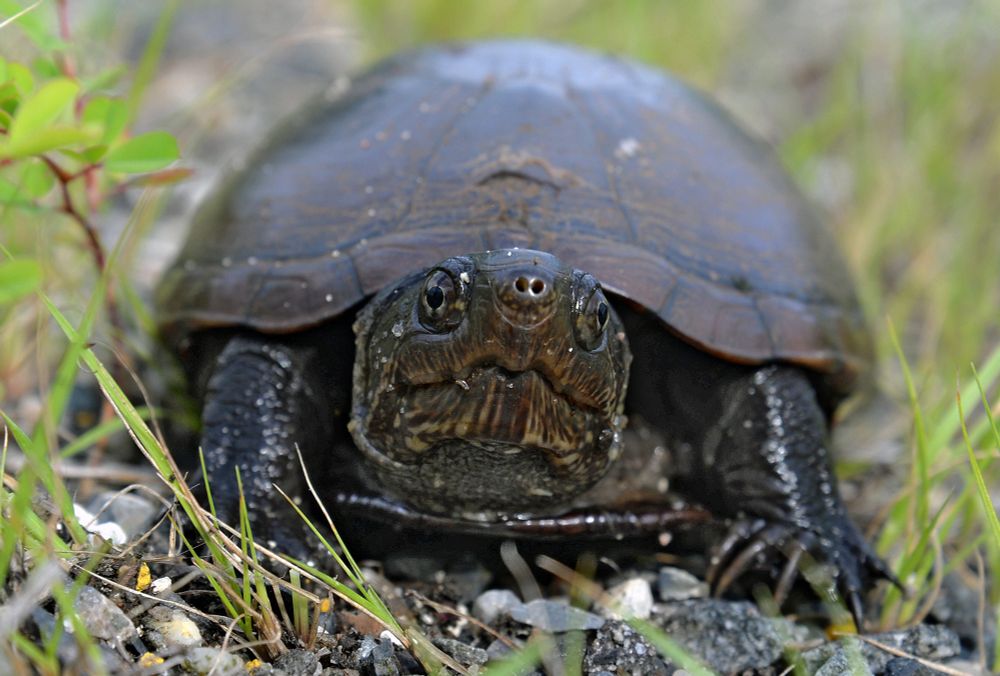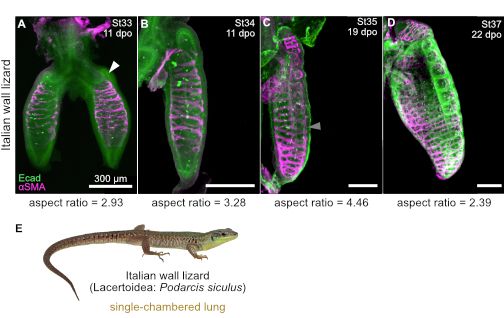
True toads (Bufonidae) originated in South America and invaded Africa via the Antarctic in the Cenozoic! (which was temperate/sub-tropical at the time). Super cool.
🐸🐸🐸
royalsocietypublishing.org/rspb/article...
@aaronhgriffing.bsky.social
biologist | postdoc | evo devo | morphology | genomes | geckos | loud music & hot sauce enthusiast | he/him https://aarongriffing.weebly.com/ #GeckoEvoDevo

True toads (Bufonidae) originated in South America and invaded Africa via the Antarctic in the Cenozoic! (which was temperate/sub-tropical at the time). Super cool.
🐸🐸🐸
royalsocietypublishing.org/rspb/article...
Very excited to share that our latest paper is out in Science! We show that the type specimen of Nanotyrannus—an isolated skull—is fully grown, showing that it is not a juvenile Tyrannosaurus rex but a distinct species (1/12)
www.science.org/doi/10.1126/...




Happy World Wildlife Conservation Day in the #NewJersey #Pinelands! Here's a sampling of the wildlife that can be found in the 1.1-million-acre Pinelands National Reserve. 🐍 🐦 🐸 🌎
📷: Pinelands Commission staff
#wildlife #WildlifeConservationDay

Now out in Evolution @journal-evo.bsky.social
Tetrapod vocal evolution reveals faster rates and higher-pitched sounds for mammals 🐘🦉🐸.
Mammalian hearing likely allowed the rapid diversification of their vocalizations.
Open access here:
doi.org/10.1093/evol...
#bioacoustics #animalcommunication




I'm happy to share that, together with @juvelas.bsky.social and Daniel Vásquez-Restrepo to examine how Andean uplift influenced the evolution of South American squamates as part of the book Andean Herpetofauna: Explorations of Diversity, Ecology and Conservation by @springernature.com (1/3)
27.11.2025 23:24 — 👍 8 🔁 3 💬 1 📌 0
@tywooldr.bsky.social et al. present assemblies for three bear species — the sun, sloth, and Andean bears — and use a whole-genome alignment of all bear species and other carnivores to reconstruct the evolution of Ursidae.
🔗 doi.org/10.1093/gbe/evaf188
#genome #evolution

Illustration of a long, slender amphibian identified as the Malagasy dagger-tooth snake (Xiphorhina Longaula). The body is coiled in an S-shape, showing smooth, scaly skin in brown and yellow tones. Two detailed close-ups of the head display its pointed snout and scale pattern. The drawing emphasizes the snake’s elongated, narrow form and distinctive head shape, highlighting its natural texture and coloration for scientific study.
🐸 Bilder-Atlas zur wissenschaftlich-populären Naturgeschichte der Amphibien in ihren sämmtlichen Hauptformen
Wien: Kaiserl. Koenigl. Hof- und Staatsdr., 1864
[Source]

A developmental series of anole lungs, progressing from early embryo (left) to late embryo (right)
Taken together, we show that there are distinct processes by which different squamate species build their lungs. Notably, the luminal pressure-driven stress ball morphogenesis in anoles appears to be derived, potentially due to the fact anoles develop in ovo so much faster than other squamates!
14.11.2025 17:57 — 👍 2 🔁 0 💬 0 📌 0
Immunofluorescence labeling E-cadherin (green) and alpha-smooth muscle actin (magenta), and phosphorylated myosin light chain (white) in the developing lungs of veiled chameleon
Notably, these structures aren’t being sculpted by smooth muscle like in mammal lungs. Rather, they are enriched for pMLC in the apical region of the epithelium, suggesting an apical-constriction mediated outgrowth. This developmental process is what bird lungs use to branch!
14.11.2025 17:56 — 👍 1 🔁 0 💬 1 📌 0
EdU assays of chameleon lungs through development. EdU signal (white) is localized to the growing tips of the transitional chambers and diverticulae.
We also found some very interesting aspects of chameleon lung development. Chameleon lungs exhibit multiple chambers and these bizarre projections called diverticulae. These chambers and diverticulae seem to grow out via concentrated cell proliferation.
14.11.2025 17:54 — 👍 1 🔁 0 💬 1 📌 0
Simulation of a epithelium and smooth muscle mesh that either increases via luminal pressure or epithelial proliferation. The latter predicts a thinner epithelium and immunfluorescence of E-cadherin (green) and alpha-smooth muscle actin (magenta) recapitulates what the simulation predicted!
We decided to computationally simulate our hypothesized process: anoles expand their epithelium via luminal pressure while chams and geckos expand their epithelium via proliferation. This simulation suggested the epithelium would be thinner in anole lungs, and sure enough, that’s what we found!
14.11.2025 17:53 — 👍 1 🔁 0 💬 1 📌 0
Immunofluorescence labeling E-cadherin (green) and EdU (white) in the developing lungs of chameleons, leopard geckos, and brown anoles.
This suggests geckos and chams don’t drastically increase luminal pressure to push the epithelium through the smooth muscle. EdU shows more cell proliferation in the epithelium of gecko and cham lungs than anoles, suggesting proliferation pushes the epithelium through the mesh in geckos and chams.
14.11.2025 17:50 — 👍 1 🔁 0 💬 1 📌 0
Immunofluorescence image labeling E-cadherin (green) and alpha-smooth muscle actin (magenta) of their developing lungs of Italian wall lizard
What we found in leopard gecko and chameleon lungs was also consistent in our opportunistic sampling of Italian wall lizard embryos.
14.11.2025 17:45 — 👍 2 🔁 0 💬 1 📌 0
Immunofluorescence labeling E-cadherin (green) and alpha-smooth muscle actin (magenta) of their developing lungs of brown anole (top) and leopard gecko (bottom)

Immunofluorescence labeling E-cadherin (green) and alpha-smooth muscle actin (magenta) of their developing lungs of veiled chameleon
We found that smooth muscle meshes show up in all three species, but what is really striking are the differences in inflation between anoles and the other two species. Aspect ratios are significantly different through development of the anole lung, but not in leopard geckos or chameleons.
14.11.2025 17:44 — 👍 1 🔁 0 💬 1 📌 0
A phylogeny of squamates demonstrating the diverse morphologies that are present in each clade with schematics of some of these distinct morphologies. The species we studied have either single-chambered lungs (brown anole & leopard gecko) or transitionally multi-chambered lungs with distal diverticulae (veiled chameleon)
We aimed to investigate whether stress ball morphogenesis is conserved in other squamates. Additionally, we wanted to see if more complex lungs exhibit distinct patterns of lung morphogenesis. To do this, we looked at embryonic lungs of leopard geckos, brown anoles, and veiled chameleons!
14.11.2025 17:42 — 👍 1 🔁 0 💬 1 📌 0
A cartoon schematic illustrating stress ball morphogenesis in the brown anole lung. The lung starts off as a wishbone shape without smooth muscle. Smooth muscle eventually differentiates and creates a mesh around the epithelium. The epithelium eventually bulges out between openings in the mesh.
Lungs are strikingly diverse and they formed in distinct ways between species. M Palmer previously showed that anoles generate their bumpy, balloon-like lungs via luminal pressure pushing the epithelium through a smooth muscle mesh (i.e. stress ball morphogenesis).
www.science.org/doi/10.1126/...

brightfield images of three lizard embryos of approximately the same developmental stage. Below each embryo image is an immunofluorescence image labeling E-cadherin (green) and alpha-smooth muscle actin (magenta) of their developing lungs
New paper out in @devdynamics.bsky.social on lizard lung development!
Project co-led w/ Kaleb Hill and also w/ @tonygamble.bsky.social @shylonatasha.bsky.social @aussiebiologist.bsky.social @bezbez.bsky.social @celestemnelson.bsky.social
anatomypubs.onlinelibrary.wiley.com/doi/10.1002/...
Collaboration with the stellar past/present members of the @celestemnelson.bsky.social and @mallarinolab.bsky.social labs!
14.11.2025 00:29 — 👍 0 🔁 0 💬 0 📌 0
Immunofluorescence of mouse, anole, and chicken lungs showing epithelium in green and smooth muscle actin in magenta
New preprint from my postdoc work! Using fluorescent imaging, scRNA-seq, and ATAC-seq of mouse, anole, and chicken embryos, we provide evidence that birds have co-opted vascular smooth muscle to generate the pulmonary smooth muscle in their lungs. More on this later!
www.biorxiv.org/content/10.1...

Super-proud of former MPhil student Emily Hillan for publishing her dissertation on the evolution of rib skeleton regionalisation in the evolution of snake-like body forms in squamates!
royalsocietypublishing.org/doi/full/10....

A study finds that chameleons have longer & more coiled optic nerves than other squamates & known tetrapods, providing slack & reduced strain during extensive eye rotation characteristic of chameleon eyes, & providing an excellent historical review of our knowledge.
www.nature.com/articles/s41...

Very happy that our new paper on the odd, looped optic nerves of chameleons is now out! It turns out having highly mobile eyes require some pretty specialized connections! doi.org/10.1038/s415...
10.11.2025 23:50 — 👍 13 🔁 8 💬 0 📌 0
Our big squamate origins and early evolution review is now fully published as open access! with @marcanthonytollis.bsky.social and F. Burbrink
www.annualreviews.org/content/jour...
Pretty stoked that our article got the cover of the latest issue of @journalofanatomy.bsky.social!
Check it out here: doi.org/10.1111/joa....
Now in Evolution: academic.oup.com/evolut/artic...
This paper started when @3rdreviewer.bsky.social, Mike, and I had a lunch at which there was a lot of, "What do you mean when you say X?" Fun to spend time thinking about when terms get too muddy, and great work by Drew to pull it all together!

Hemipene from a water snake with spines segmented to illustrate diversity of shape within one species, some are like claws, others more needle like
Recent paper from our lab on the puncture performance of hemipene spines in snakes! Some are like cat claws, others barely puncture. A single species can have many different spine morphologies and thousands of spines! 🧪 🐍
royalsocietypublishing.org/doi/full/10....
I'll also be looking to recruit an MS student to study the functional morphology and biomechanics of adhesion, friction, and/or locomotion in sea urchins, geckos, or anoles! Please share! @sicb-dcb-dvm.bsky.social @sicb.bsky.social
02.11.2025 02:28 — 👍 7 🔁 14 💬 1 📌 0
Genome Biology and Evolution | November 2025 cover
The November cover of Genome Biology and Evolution features @raularayadonoso.bsky.social @kenrokusumi.bsky.social @anthonygeneva.bsky.social et al., who studied how structural rearrangements and selection promote phenotypic evolution in Anolis.
🔗 doi.org/10.1093/gbe/evaf196
#genome #evolution

"The project that was terminated was on this hummingbird, the white-necked jacobin....I suspect that it has something to do with studying a species that doesn’t fit the binary." Researcher @jjinsing.bsky.social interviewed by @carlzimmer.com #birds #nature #science #fundscience #nonbinary 🧪
31.10.2025 14:02 — 👍 139 🔁 52 💬 0 📌 4

Ever seen a clear and stained little brown bat (Myotis lucifugus)? 🦇
I love how their modified forelimbs, with elongated phalanges that support the wing membrane used for flight. Look how big those fangs are! 🧪🎃